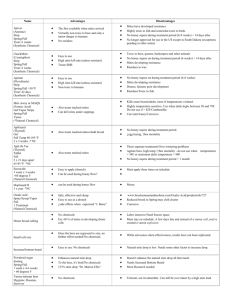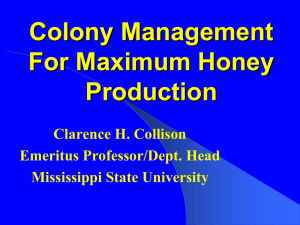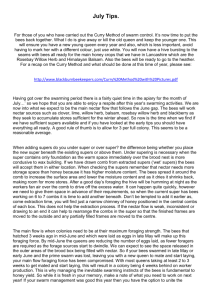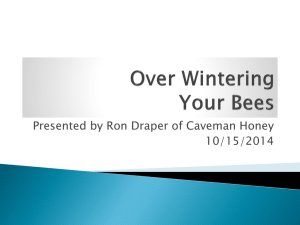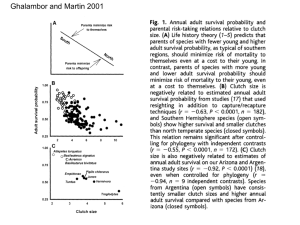Honey bee Diseases
advertisement
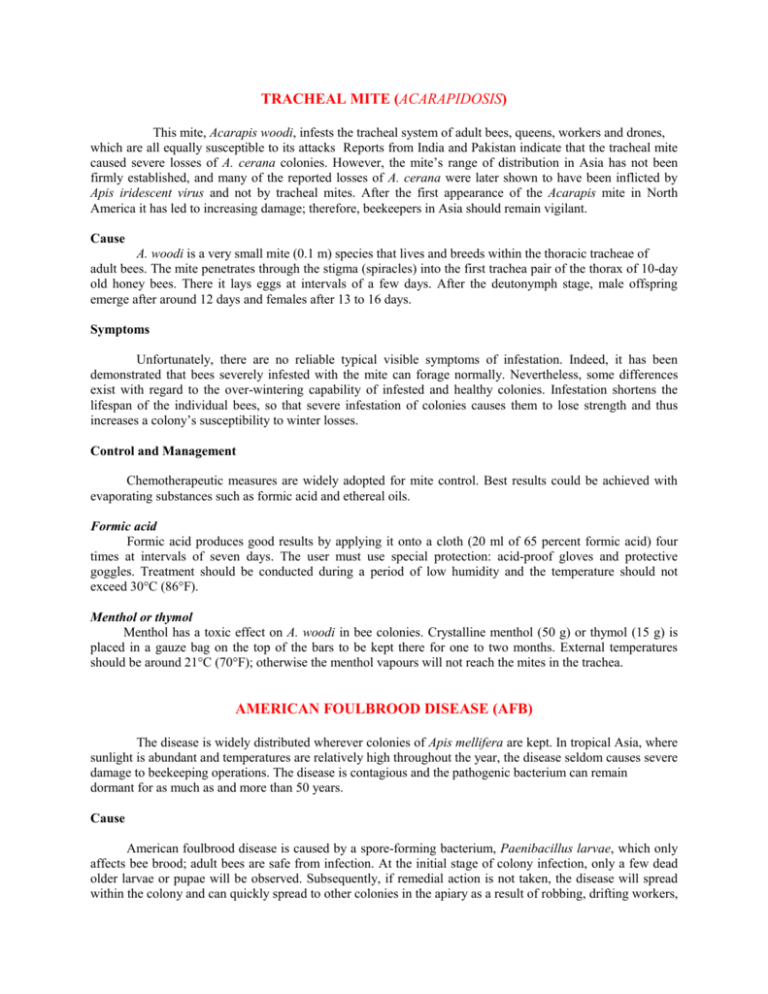
TRACHEAL MITE (ACARAPIDOSIS) This mite, Acarapis woodi, infests the tracheal system of adult bees, queens, workers and drones, which are all equally susceptible to its attacks Reports from India and Pakistan indicate that the tracheal mite caused severe losses of A. cerana colonies. However, the mite’s range of distribution in Asia has not been firmly established, and many of the reported losses of A. cerana were later shown to have been inflicted by Apis iridescent virus and not by tracheal mites. After the first appearance of the Acarapis mite in North America it has led to increasing damage; therefore, beekeepers in Asia should remain vigilant. Cause A. woodi is a very small mite (0.1 m) species that lives and breeds within the thoracic tracheae of adult bees. The mite penetrates through the stigma (spiracles) into the first trachea pair of the thorax of 10-day old honey bees. There it lays eggs at intervals of a few days. After the deutonymph stage, male offspring emerge after around 12 days and females after 13 to 16 days. Symptoms Unfortunately, there are no reliable typical visible symptoms of infestation. Indeed, it has been demonstrated that bees severely infested with the mite can forage normally. Nevertheless, some differences exist with regard to the over-wintering capability of infested and healthy colonies. Infestation shortens the lifespan of the individual bees, so that severe infestation of colonies causes them to lose strength and thus increases a colony’s susceptibility to winter losses. Control and Management Chemotherapeutic measures are widely adopted for mite control. Best results could be achieved with evaporating substances such as formic acid and ethereal oils. Formic acid Formic acid produces good results by applying it onto a cloth (20 ml of 65 percent formic acid) four times at intervals of seven days. The user must use special protection: acid-proof gloves and protective goggles. Treatment should be conducted during a period of low humidity and the temperature should not exceed 30°C (86°F). Menthol or thymol Menthol has a toxic effect on A. woodi in bee colonies. Crystalline menthol (50 g) or thymol (15 g) is placed in a gauze bag on the top of the bars to be kept there for one to two months. External temperatures should be around 21°C (70°F); otherwise the menthol vapours will not reach the mites in the trachea. AMERICAN FOULBROOD DISEASE (AFB) The disease is widely distributed wherever colonies of Apis mellifera are kept. In tropical Asia, where sunlight is abundant and temperatures are relatively high throughout the year, the disease seldom causes severe damage to beekeeping operations. The disease is contagious and the pathogenic bacterium can remain dormant for as much as and more than 50 years. Cause American foulbrood disease is caused by a spore-forming bacterium, Paenibacillus larvae, which only affects bee brood; adult bees are safe from infection. At the initial stage of colony infection, only a few dead older larvae or pupae will be observed. Subsequently, if remedial action is not taken, the disease will spread within the colony and can quickly spread to other colonies in the apiary as a result of robbing, drifting workers, or contamination caused by the beekeeper's hive manipulations. In the same way the pathogen agent can spread to other apiaries. Natural transfer mainly takes place within a radius of 1 km around the apiary. Often spores enter the bee colonies via foreign honey. Commercially available honey may be highly contaminated; therefore, special attention should be paid near honey processing enterprises and waste disposal sites. Symptoms At the initial stage of AFB infection, isolated capped cells from which brood has not emerged can be seen on the comb. The caps of these dead brood cells are usually darker than the caps of healthy cells, sunken, and often punctured. On the other hand the caps of healthy brood cells are slightly protruding and fully closed. As the disease spreads within the colony, a scattered, irregular pattern of sealed and unsealed brood cells can be easily distinguished from the normal, compact pattern of healthy broodcells observed in healthy colonies. The bee brood affected by AFB is usually at the stage of older sealed larvae or young pupae, upright in the cells. Often therefore, a protruding tongue can be found with the rest of the body already decayed. At first the dead brood is dull white in colour, but it gradually changes to light brown, coffee brown, and finally dark brown or almost black. The consistency of the decaying brood is soft. Once the dead brood have dried into scales, the test cannot be used. The dry brood lies flat on the lower side of the cell wall, adhering closely to it – in contrast to sacbrood. This scale is usually black or dark brown and brittle. Often, a fine, threadlike proboscis or tongue of the dead pupa can be seen protruding from the scale, angling toward the upper cell wall. Control and Management In several countries, where apiculture includes large commercial operations, frequent, efficient inspection services are particularly advanced and a ‘search and destroy’ strategy may be adopted in an attempt to minimize damage to apiaries caused by this serious honey bee disease. The procedure involves hive inspections by qualified apiary inspectors. The entire honey bee population that is infected by American foulbrood is killed and hive materials belonging to the colony, are disinfected or destroyed by burning. The bees are usually killed by poisonous gas such as the burning of sulphur powder. All the dead bees, the frames, the supers, the honey and the contaminated equipment are thrown into a 1m x 1m x 1m hole in the ground. Kerosene is poured over the pile and set alight. When all the material has been completely burned, the hole is carefully filled in, to prevent worker bees belonging to healthy colonies from robbing any remaining contaminated honey. Although the above-mentioned method has proven effective, the practice of burning AFB infected colonies and equipment is costly, especially taking into account the high cost of beekeeping equipment. The destruction of brood combs and food combs is absolutely necessary as, apart from the bees, they are the main carriers of spores. Dry combs, without brood, can be preserved if an examination of wax samples in the laboratory does not reveal Paenibacillus spores. In which case the dry combs must also be destroyed. Old hives should be burned. Well conserved hives, however, should be disinfected. The inner part of an hive, once carefully cleaned, can quickly be singed out with the flame of a gas burner. The wooden surface should look slightly brownish. When this is not possible, e.g. if the hive is made from plastic, they should be cleaned and brushed with 3 to 5 percent sodium hydroxide. Before using other substances for disinfection you should make sure that no residues remain that could be dangerous to bees or the consumer of the processed honey. The killing of the bees can be avoided if the artificial swarm method is applied. A traditional method is to keep the bee colony in a dark environment for several days. The bees are pushed into a decontaminated hive with new combs, the bee entrance is closed and they are placed in a dark preferably quite cool room. Within two days, the bees have used up the contaminated food. The colonies can then be placed either at their former stand or within a distance of at least 3 km away. If the bees are kept in the dark for three days they forget their old stand and can be placed anywhere. On the third day, however, some food shortage may occur. Therefore, the colonies should be fed. The direct artificial swarm method is less complicated. First, a clean, decontaminated hive is prepared. Instead of combs it contains three to six wooden bars, depending on the colony’s strength, provided with a wax strip as a starter for further comb construction. Using a queen excluder fixed at the entrance or above the bottom of the hive should prevent disappearance of the queen. The prepared hive is placed at the colony’s old stand subject to sanitation. Now the bees are pushed or brushed into the empty hive. Three days later, the combs that have been partially constructed by the bees are removed again and burned. Combs with midribs later replace these. Now sanitation is finished. The combs and the hive of the old colony are burned or decontaminated. In some countries, beekeepers who destroy their AFB-infected colonies receive compensation, either directly from the government or from beekeepers’ organizations. Chemotherapeutic methods of controlling AFB involve the administration of antibiotics or sodium sulfathiazole, in various formulations, fed mixed with powdered sugar or sugar syrup. Antibiotics and sulfonamides prevent multiplication of the agent, though it will not kill the spores. Therefore, multiplication may begin again shortly after treatment, which is why treatment must be repeated in shorter and shorter intervals. Over time the inner part of the hive, the food and honey become increasingly contaminated by spores. Stopping treatment without simultaneous disinfection leads irrevocably to a relapse. However, detectable residues remain even after a period of time has elapsed between treatment and honey extraction. EUROPEAN FOULBROOD DISEASE (EFB) The range of distribution of European foulbrood disease is not confined to Europe alone and the disease is found in all continents where Apis mellifera colonies are kept. Reports from India indicate that A. cerana colonies are also subject to EFB infection. The damage inflicted on honey bee colonies by the disease is variable. EFB is generally considered less virulent than AFB; although greater losses in commercial colonies have been recorded in some areas resulting from EFB. Cause The pathogenic bacterium of EFB is Mellissococcus pluton. It is lanceolate in shape and occurs singly, in chains of varying lengths, or in clusters. The bacterium is Gram-positive and does not form spores. Symptoms Honey bee larvae killed by EFB are younger than those killed by AFB. Generally speaking, the diseased larvae die when they are four to five days old, or in the coiled stage. The colour of the larva changes at it decays from shiny white to pale yellow and then to brown. When dry, the scales of larvae killed by EFB, in contrast to AFB scales, do not adhere to the cell walls and can be removed with ease. The texture of the scales is rubbery rather than brittle, as with AFB. A sour odour can be detected from the decayed larvae. The clinical picture and the odour can vary depending on the kind of other bacteria involved (Bacillus alvei, Streptococcus faecalis, Achromobacter eurydice). Another symptom that is characteristic of EFB is that most of the affected larvae die before their cells are capped. The sick larvae appear somewhat displaced in the cells. When a scattered pattern of sealed and unsealed brood is observed in a diseased colony, this is normally an indication that the colony has reached a serious stage of infection and may be significantly weakened. However, this is the case with all brood diseases. EFB is transferred in the same way as AFB. Melissococcus pluton as a permanent form, does not form spores but capsules which are less resistant than the spores of P. larvae. Control The choice of an EFB control method depends on the strength of the infection, i.e. how many brood cells and combs are infested. If the infection is weak, it is often sufficient to stimulate the hygiene behaviour of the bees. Either they are placed at a good foraging site or they are fed with honey or sugar water. An even better result is achieved if the individual combs are sprayed with a thinned honey solution. If the infestation is stronger it makes sense to reduce the number of pathogens in the colony by removing the most infested brood combs. Empty combs or healthy brood combs then replace these. Since the bees’ hygiene behaviour is also genetically determined, replacement of the queen is also possible. Requeening can strengthen the colony by giving it a better egg-laying queen, thus increasing its resistance to the disease and interrupting the ongoing brood cycle giving the house bees enough time to remove infected larvae from the hive. In serious cases, the same methods can be used as for AFB. Sometimes chemotherapeutic measures such as antibiotics are called for, however, their application, always risks the danger of residues. SMALL HIVE BEETLE (SHB) infestation: Originally, this beetle (Aethina tumida), was only found in Africa, south of the Sahara. It first appeared in the southern United States of America in 1998 and has continued to spread north as far as Canada. Since 2002 this beetle has been found in parts of Australia. In Africa, the beetle’s original range, only weak colonies or storage combs are affected. However, in America or Australia, colonies of ordinary strength can be affected. The main reason for this seems to be the different defence behaviour of the imported European bees. On the other hand, the beetle also invades a colony during management activities, e.g. during honey extraction. There is a risk that the beetle may spread to Asia. Cause The beetle Aethina tumida (order: Coleoptera, family: Nitidulidae) is called the small hive beetle’.This beetle lives and multiplies within and outside bee colonies. The beetle deposits larger deposits of nests of eggs within a bee colony, in fissures and recesses out of reach of the bees. The larvae of this beetle preferably live on and in pollen and honeycombs. The adult larvae leave the hive to pupate in the earth in front of the apiary. The period of development from egg to adult beetle is at least four to five weeks. Symptoms The beetles and their larvae can infest bee brood and honeycombs in and outside the apiary. There they form eating canals and destroy the cell caps, and the honey starts to ferment. The beetles larvae and faeces also change the colour and taste of the honey and the combs appear mucilaginous. The adult beetle is dark brown to black, around 5 mm long and 3 mm wide. Whereas the beetle may be found throughout the bee hive, the white larvae, around 11 mm long are mainly found in the combs.They can easily be distinguished from the wax moths that may also be living in the bee colony because their legs are longer and they have a row of spines on their back and do not spin nets or cocoons. A minor infestation is difficult to recognize because the beetles immediately hide in the dark. The most secure diagnosis is achieved after chemical treatment when the dead beetles can be gathered from the bottom inlay. Control The best way to protect against an infestation of the small hive beetle is to keep strong colonies and to remove those that are weak from an apiary. The removed honey combs should be centrifugally extracted one to two days after harvesting the honey. These can be stored at less than 10°C or in a dry environment having less than 50 percent relative air humidity, which may prove too complicated for the individual beekeeper. Currently, a successful control is made possible using a preparation named ‘Checkmate’, produced by Bayer (a.i. Cournaphos). This product has provisional market approval in some states of the United States. More than 90 percent of adult beetles and larvae may be killed with this preparation. Other chemical treatments are under development. However, the problem is that this beetle – contrary to the varroa mite – can live and multiply outside the bee hive, where it seems to prefer rotting fruits (e.g. apples and bananas) as nesting sites. This is why reinvasion is always possible. The beetle is extremely quick moving and can fly, which contributes to its rapid spread among bee colonies and apiaries. TROPILAELAPS INFESTATION The mite is a native parasite of the giant honey bee Apis dorsata, widely distributed throughout tropical Asia, and whenever A. mellifera is kept within the range of distribution of A. dorsata, mite infestation of the colonies cannot be avoided. Thus, in Thailand beekeepers consider Tropilaelaps to be a more serious pest than varroa-mites, even though it may be easier to control. Cause Tropilaelaps mites are much smaller than varroa mites, although the trained unaided eye can still see them. The adult female mite is light reddish-brown in colour, with an oval-shaped body about 0.96 mm in length and 0.55 mm in width. The mite’s entire body is covered with short setae. A red streak running longitudinally on the ventral surface of the adult female, the fusion of her epigynial and anal shields may be perceived through a strong magnifying glass. Symptoms The abdomen of bees surviving mite attacks is reduced in size, and they have a shorter life-span than healthy bees. In heavily infested colonies, bees with deformed wings can be observed crawling about the vicinity of the hive entrance and on the comb surfaces, while pieces of dead bee brood evacuated from the hive by the house bees can be seen in front of the entrance. Inspection of hives severely infested by Tropilaelaps reveals an irregular pattern of sealed and unsealed brood as found with all brood diseases. Control and Management: Chemical control Formic acid can be used successfully in its treatment. The dosage per comb should not exceed 2 ml in a one-storey Langstroth-hive. The formic acid is placed onto a cloth deposited in the rear section of the hive. Formic acid is strongly caustic; therefore, the user should wear acid-proof gloves and protective goggles.Applications of amitraz are very effective either as a liquid spray on the surface of the brood comb and hive walls, or as a hive fumigant, in the same dosages. The treatment requires three to four applications at four-day intervals. The precautions to be taken in treating Tropilaelaps are the same as for varroa; all chemical treatments must be suspended at least eight weeks before the honeyflow season arrives, and amitraz must not be used in spray form in the presence of large numbers of honey bee eggs and newly-hatched larvae. Colony manipulation techniques Many beekeepers prefer not to use chemicals to control Tropilaelaps, but to manipulate the brood rearing cycle of their infested colonies in such a way that the mites are deprived of sealed and unsealed brood, their food, for at least three days. During this period, a large proportion of the mite population will starve to death. There are several means of creating this broodless situation in infested colonies. In smaller apiaries, the beekeeper can simply remove the brood-comb frames -- both sealed and unsealed from the infested colonies and put them in new hives. Before the new larvae hatch, the hives manipulated in this way will be short of brood for two to three days, time enough to starve most of the mites. The new hives with the removed brood frames are given mated queens, which are caged for 14 days, a period that allows most of the brood to emerge, while no new brood has been reared because the queen has been confined. When the drone population in the colonies is high, and the beekeeper wishes to increase the number of colonies, the new ones may be given newly-reared, capped queen cells instead of mated queens. By the time the virgin queens emerge, mature, mate and are ready to lay, most of the brood will have emerged; the rest can be destroyed before egglaying begins. There will be thus sufficient time to starve most of the mite population in the colonies. The best time of year to carry out these colony-manipulation techniques is during a heavy pollen-flow season, enabling the colonies to rear brood after the period of brood deprivation. In some Asian regions, this season coincides with the monsoon months, when there is no nectar flow but when pollen is abundant. This is also the season in which beekeepers feed sugar syrup to their bees, rear new queens and propagate colonies. While colony manipulation to control Tropilaelaps is time-consuming, it causes no noticeable harm to the colonies, nor does it affect productivity. The availability of pollen, coupled with the feeding of sugar, enables both the treated and the newly-formed colonies to regain their full strength before the nectar flow begins. Some beekeepers prefer to combine chemical treatment with the brood-deprivation technique. In this approach, all sealed brood is removed from the mite-infested colonies, which are then fumigated. The adult female mites, having no capped brood cells in which to hide, are for the most part killed by the fumigant, so that only one chemical treatment is required instead of three or four. Recent examinations have shown that, in special cases, the Tropilaelaps mite can survive longer than seven days without bee brood. Despite this, these bio-technical methods have the advantage that the number of mites in the bee colonies is drastically reduced and damage is avoided. VARROA MITE (VARROASIS) This mite is a native parasite of A. cerana throughout Asia. The overall effect of varroa infestation is to weaken the honey bee colonies and thus decrease honey production. This parasite is found throughout the world, except for Australia and New Zealand South Island. Cause Varroa destructor (previously confused with Varroa jacobsonii) is quite large, as compared with other mite species, and can be seen with the unaided eye. The shape of the adult female is distinctive: observed from above, the width of the body is clearly seen to be greater than the length, i.e. about 1.6 x 1.1 mm. The mite is reddish brown in colour and shiny and the body is dorsoventrally flattened covered with short hairs (setae). Adult females of V. destructor are found inside brood cells or walking rapidly on comb surfaces. Individual mites are often seen clinging tightly to the body of adult bees, mostly on the abdomen, where the segments overlap, between the thorax and the abdomen and at the ventral entry. The immature mites are bright white and the adult females are brown, while male mites are smaller than females and are rarely seen since they are only found inside brood cells. Symptoms Varroa causes injuries to honey bees by direct feeding. The adult female pierces the bees’ soft intersegmental membrane with their pointed chelicera and sucks the bees` haemolymph (‘blood’). Varroasis is a brood disease. If more than one parasitic female mite infests the brood cell the brood decays or deformations occur including shortened abdomen or deformed wings. If only one mite infests a cell symptoms may not be visible, although the bees’ life-span is considerably shortened. Moreover, the bee’s behaviour may be disturbed, e.g. in orientation or gathering food. Infested bees often have a reduced fat body that hampers the functioning of their glands or increases their susceptibility to pesticides. The semen production of drones may be considerably reduced. Control and Management: Two principal approaches to its control are currently available: (i) chemical control and (ii) hive manipulation techniques, referred to as ‘biological control’. (i)Chemical control: Among the commonly-used mite-control agents are organic acids, ethereal oils, synthetic pyrethroids and amitraz The application of chemical substances can only be started after honey harvest, i.e. after extraction of the honey chamber, respectively the honey combs. This is the only way to avoid residues. Formic acid can kill some of the mites in the sealed brood cells. It is recommended that the formic acid be allowed to evaporate in colonies with sealed brood for at least two to three weeks. In this way, mites emerging from the brood will also be killed. Various applicators have proved effective for this purpose. A small container equipped with a wick or paper felt is filled with 200 ml of 85 percent formic acid to evaporate for at least 14 days. The quantity to evaporate can be regulated by means of the length of the wick or the size of the paper felt. The container is either placed on top of the combs, in an empty upper section or after some combs have been taken out, in the empty space. The external temperature should not be less than 12°C (54°F) and not more than 25°C (77°F). The formic acid should be introduced into the colony only in the late afternoon to avoid damage to bees and brood. In addition, physiological tolerance is improved if the entrance hole is wide open. An easier way to introduce formic acid is to use a sponge or a similarly absorbent material. A solution of 3 ml of 60 percent formic acid is applied onto the sponge tissue per comb (Langstroh size). The quantity must be reduced accordingly for smaller comb sizes. A grid fixed above the tissues on the bottom of the hive, will prevent the bees from burning themselves with the acid. The grid should be as far away from the brood as possible. The application can be repeated three to four times at intervals of at least seven days. Oxalic acid : Contrary to formic acid oxalic acid does not act via evaporation but through contact with the bees. Thirty five grams of crystal oxalic acid (dihydrate) is thinned in one litre of sugar water (1:1). When handling crystal acid special precautions must be taken because of the health risks. Protective spectacles and acid-proof gloves must be work together with an adequate mouth protector. Depending on the size of the colony 20 to 30 ml of the suspension per chamber are dropped into the bee-ways. A repetition of the treatment can lead to damage to the bees. Applicators are available by which the acid can be evaporated. Lactic acid: Lactic acid is clearly better tolerated by beesand does not cause problems in warmer climatic zones. The disadvantage is that every single comb must be extracted to spray the bees with the acid. The dosage applied per comb side is 8 ml of 15 percent acid. This treatment can be repeated several times at intervals of seven days. Etheric oils The only etheric oil that is sufficiently affective against varroa mites is thymol. Thymol can be applied as a commercially available ready-made preparation or in crystal form. For this purpose, 0.5 mg thymol per bee-way are put into a gauze bag and deposited onto the combs for some weeks. In this way mites emerging from the brood will be covered. Synthetic chemicals Pyrethroids Synthetic pyrethroids are contained in Apistan and Bayvarol, which have been developed for application to bees. The plastic strips are fixed in bee-ways in the brood nest. When the bees come into contact with them they transport the substance to the other bees, thus killing the parasitic mites on the bees. As the strips remain for several weeks in the colony mites emerging from the brood are affected. Synthetic pyrethroids are highly effective, although there is the disadvantage that mites may rapidly develop resistance to them. Therefore, their effectiveness should be controlled regularly. Synthetic pyrethroids are also available in formulations notspecifically intended for use on bees. Amitraz Taktic and Mitac are trade names of products containing amitraz at different concentrations. The recommended dosage for use on honey bee colonies is 1 ml of 12.5 percent amitraz to 10 litres of water, sprayed lightly on bees, the comb surface of brood frames and hive walls. The amount of the solution to be sprayed at each application depends on the size of the colony, but is usually within the range of 80 to 250 ml. Amitraz can also be used as a hive fumigant. Strips of filter paper 2.5 x 9 cm are soaked in a saturated solution of potassium or sodium nitrate and allowed to dry, then 0.1 ml of the product is applied onto each paper strip. Fumigation should take place in the evening, when the foragers have returned to the hive. The technique is simple: an impregnated strip of paper is fastened to anempty frame, lit and allowed to smoulder from the bottom end upward. The frame is inserted into the hive, supported by an empty super placed above the brood chamber. The hive entrance is closed, and all cracks are sealed with masking tape. The entrance can be reopened after 20 to 30 minutes. If sealed brood is abundantly present in the infested colony, the treatment must be repeated two to three times at four-day intervals. (ii) Hive manipulation Technique The varroa mite depends on bee brood to complete its development cycle. Since the mite prefers drone brood to worker brood, empty frames are given to the colonies, which will rear drone brood in them. When the cells are sealed, the frames, containing the mites trapped inside the cells, can be removed and destroyed. The mites can also be trapped in worker-brood frames by using vertical queen excluders in singlestorey hives. The queen is confined between two excluders and allowed to lay eggs in one frame only. Female mites in the colony will be attracted to this brood frame which, when the cells are sealed, is removed from the colony so that the brood cells infested by the parasites can be destroyed.

